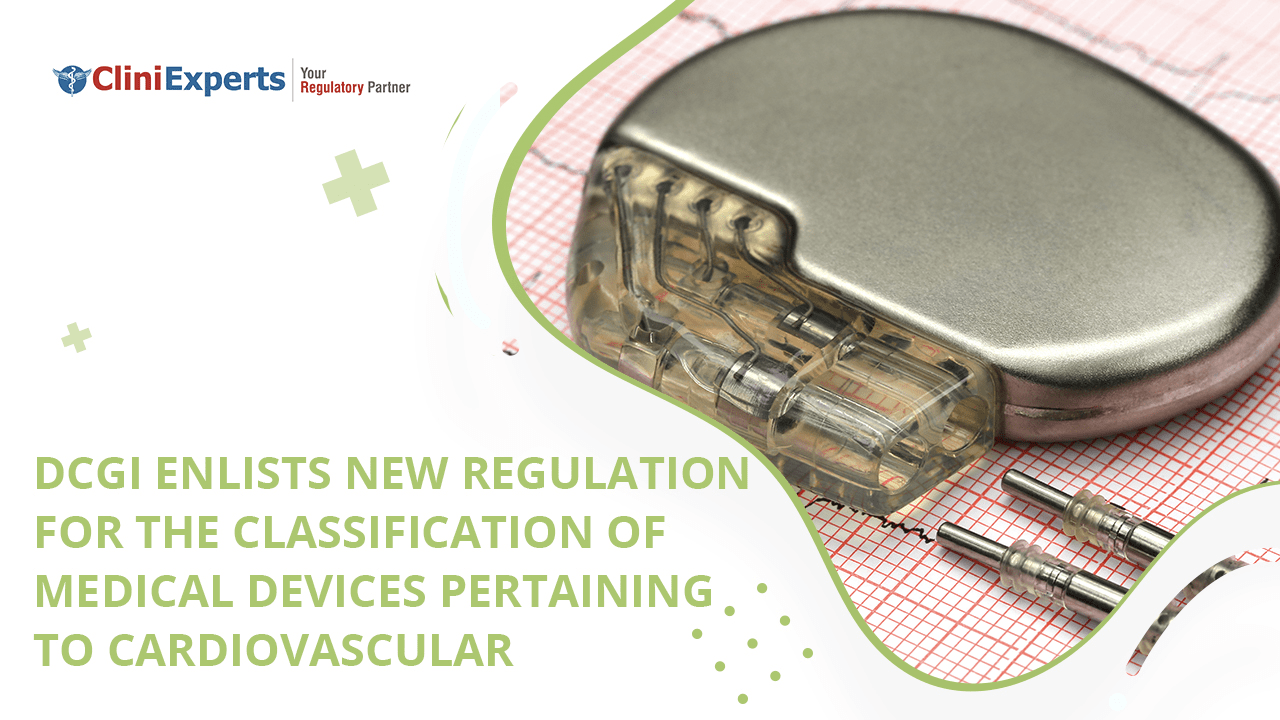DCGI Enlists New Regulation For The Classification Of Medical Devices Pertaining To Cardiovascular

The Drugs and Cosmetics Act of 1940, as well as the rules promulgated under it, govern the safety, quality, and performance of medical devices. The Central Government has notified Medical Devices Rules, vide G.S.R. 78 (F) dated 31.01.2017, for the regulation of medical devices with respect to import, manufacture, sale and distribution, clinical investigation, after consulting with the Drugs Technical Advisory Board
DCGI enlists classification for Medical Devices pertaining to Cardiovascular
The Drugs Controller General (India) (DCGI), has enlisted a new classification of medical devices pertaining to cardiovascular. DCGI implemented this classification on July 26, 2021.
Classification of medical devices
Under the provisions of Medical Devices Rules, 2017, the medical devices are classified into four risk classes, i.e., Risk Class A, B, C, and D. Tables 1 gives the list of all medical devices and their classification pertaining to Cardiovascular.
Table 1: Classification of medical devices pertaining to Cardiovascular
| S.No | Medical Device Name | Intended Use | Risk Class |
1 | Arrhythmia Detector and Alarm (Including St-Segment Measurement and Alarm) | The arrhythmia detector and alarm devices keep watch on an electrocardiogram and are delineated to create a visible and audible alarm when atrial or ventricular arrhythmia, like premature contraction or ventricular fibrillation, happens. | C |
2 | Cardiac monitor (including cardiotachometer and rate alarm) | A cardiac monitor (inclusive cardiotachometer and rate alarm)is a medical device that is generally utilized to determine the heart rate from an analog signal generated by an electrocardiograph, vector cardiograph, or blood pressure monitor. This device starts sending alarms when the heart rate decreases or increases outside the preset limits. | B |
3 | Apex cardiograph(vibro cardiograph) | An apex cardiograph(vibro cardiograph) is a medical device that amplifies or condition signals produced by apex cardiographic transducers and displays a visual display of the heart’s motion. These devices also provide the excitation energy required by the transducers. | B |
4 | Echocardiograph | An echocardiograph medical device utilizes ultrasonic energy to produce images of cardiovascular structures. It has phased arrays and two-dimensional scanners. | B |
5 | Electrocardiograph | An electrocardiograph is a medical device that processes the transmitted electrical signal through two or more electrocardiograph electrodes and to creates a visual graph of the electrical signal generated by heart. | B |
6 | Electrocardiograph electrode | An electrocardiograph electrode works as an electrical conductor that is operated on the body surface to pass on the electrical signal at surface of the body to a process or that generates an electrocardiogram or vector cardiogram. | B |
7 | Vascular clip | A vascular clip is an extravascular medical device that is implanted to compress small blood vessels, outside the intracranial system, so that blood cannot flow through them. | B |
8 | Venacava clip | Vena cava clips are implanted extravascular devices anticipated to partially congest the vena cava and inhibit thromboembolic events. | B |
9 | Intra-aortic balloon | An intra-aortic balloon is a prescription device that consists of an inflatable balloon, which is placed in the aorta in certain life-threatening situations to boost cardiovascular functioning and a control unit to regulate inflation and deflation. | C |
10 | Intra-aortic balloon control system (balloon pump) | An intra-aortic balloon control system is synchronized with an electrocardiogram to monitor the inflation an deflation setting concerning the cardiac cycle. | B |
11 | Ventricular bypass(assist)device | A ventricular bypass device provides assistance to the left and right ventricle to maintain circulatory blood flow. These device scan be implanted either fully or partially in the body. | D |
12 | Pacing system analyzer | Apacing system analyzer(PSA)isa prescription device that consolidates the operation of apace maker electrode function tester and an external pacemaker pulse generator(EPPG).PSA is associated with a pacemaker lead and utilizes a power supply and electronic circuits to supply an accurately calibrated, variable pacing pulse for computing the patient’s pacing threshold and intracardiac R-wave potential. APSA maybe a single, dual, or triple chamber system and at the same time, it can deliver pacing the rapy while testin gone or more implanted pacing leads. | C |
13 | Implantable pacemaker pulse generator | An implantable pacemaker pulse generator has a power supply and electronic circuits that generate a periodic electrical pulse to stimulate the heart. This device is used as a supplant for the heart’s intrinsic pacing system to fix both intermittent and continuous cardiacrhythm disorders. This device may include triggered, inhibited, and asynchronous modes and is implanted in the human body. | D |
14 | Pacemaker lead adaptor | A pacemaker lead adaptor is a medical device that can be associated with a pacemaker pulse generator produced by a different manufacturer. | C |
15 | Pacemaker generator function analyzer | A pacemaker generator function analyzer is a device that is united with a pacemaker pulse generator to identify any or all of the generator’s parameters, including pulse duration, pulse amplitude, pulse rate, and sensing threshold. | C |
16 | Cardiovascular permanent or temporary pacemaker electrode | A temporary pacemaker electrode consists of flexible insulated electrical conductors with one end linked to an external pacemaker pulse generator and the other end associated with the heart. This medical device is used to carry a pacing electrical stimulus from the pulse generator to the heart and/or to transfer the electrical signal of the heart to the pulse generator. | C |
17 | Pace maker test magnet | A pacemaker test magnet is used to determine an inhibited or triggered type of pacemaker pulse generator and cause an inhibited or triggered generator to revert to asynchronous operation. | A |
18 | Pacemaker programmers | A pacemaker programmer medical device is usually designed to non-invasively change one or more of the electrical operating characteristics of a pacemaker. | C |
19 | Pacemaker repair or replacement material | A pacemaker repair or replacement material is basically an adhesive, a sealant, a screw, a crimp, or any other material to repair a pacemaker lead or to reconnect a pacemaker lead to a pacemaker pulse generator. | D |
20 | Annuloplasty ring | For valvular insufficiency treatment, an annuloplasty ring is used. It is a rigid or flexible ring implanted around the mitral or tricuspid heart valve. | C |
21 | Carotid sinus nerve stimulator | A carotid sinus nerve stimulator is an implantable device. It can be used to decrease arterial pressure by stimulating Hering’s nerve at the carotid sinus. | D |
22 | Replacement heart valve | Replacement heart valves are made up of prosthetic materials or valves constructed of a combination of prosthetic and biologic materials. This device intended to perform the function of any of the heart’s natural valves. | D |
23 | Endomyocardial biopsy device | An endomyo cardial biopsy device is a device used in a catheterization procedure for removing samples of tissue from the inner wall of the heart. | D |
24 | Extracorporeal circuit and accessories for long-term respiratory/cardiopulmonary failure | An extracorporeal circuit and accessories for long-term respiratory/cardiopulmonary support (>6 hours) is a system of devices and accessories that provides assisted extra corporeal circulation and physiologic gas exchange of the patient’s blood in patients with acute respiratory failure or acute cardio pulmonary failure, where other available treatment options have failed, and continued clinical deterioration is expected or the risk of death is imminent. The devices and accessories include, console(hardware), software, and disposables, oxygenator, blood pump, heat exchanger, cannulae, tubing, filters, and other accessories (e.g., monitors, detectors, sensors, connectors). | C |
25 | Cardiopulmonary bypass bubble detector | A cardiopulmonary bypass bubble detector is a device used to detect bubbles in the arterial return line of the cardiopulmonary bypass circuit. | B |
26 | Cardiopulmonary bypass vascular catheter, cannula, or tubing | A cardiopulmonary bypass vascular catheter, cannula, or tubing is a device used in cardiopulmonary surgery to cannulate the vessels, perfuse the coronary arteries, and to interconnect the catheters and cannulas with an oxygenator. The device includes accessory bypass equipment. | B |
27 | Cardiopulmonary bypass heart-lung machine console | A cardiopulmonary bypass heart-lung machine console is a device that consists of a control panel and the electrical power and control circuitry for a heart-lung machine. The console is designed to interface with the basic units used in a gas exchange system, including the pumps, oxygenator, and heat exchanger. | B |
28 | Cardio pulmonary bypass defoamer | To remove gas bubbles from blood during cardio pulmonary bypass surgery are removed by cardiopulmonary bypass defoamer in conjunction with an oxygenator. | C |
29 | Cardio pulmonary bypass heat exchanger | For extra corporeal circulation to warm or cool the blood or perfusion fluid flowing through the device a cardiopulmonary bypass heat exchanger device is used. | B |
30 | Cardiopulmonary bypass temperature controller | A cardiopulmonary bypass temperature controller is a medical device used to control the temperature of the fluid entering and leaving a heat exchanger. | B |
31 | Cardio pulmonary bypass arterial line blood filter | This device is used as part of a gas exchange (oxygenator) system to filter non biologic particles and emboli (blood clots or foreign material pieces flowing in the blood stream which will obstruct circulation by blocking a vessel) out of the blood. It is used in the arterial return line. | C |
32 | Cardiopulmonary bypass cardiotomy suction line blood | It is a filtering device to filter non biologic particles and emboli (a blood clot or a piece of foreign material flowing in the bloodstream which will obstruct circulation by blocking a vessel)out of the blood. A cardiopulmonary bypass cardiotomy suction line blood filter is used as part of a gas exchange (oxygenator) system. | B |
33 | Cardio pulmonary bypass pulsatile flow generator | To create pulsatile blood flow A cardiopulmonary bypass pulsatile flow generator used. It is an electrically and pneumatically operated device. The device is placed in a cardio pulmonary bypass circuit downstream from the oxygenator. | D |
34 | Intraluminal artery stripper | To Perform an endarterectomy (removal of plaque deposits from arterisclerotic arteries.) an intraluminal artery stripper device used. | B |
35 | External cardiac compressor | It is a prescription device which is applied which is applied externally that is electrically, pneumatically, or manually powered and is used to compress the chest periodically in the region of the heart to provide blood flow during cardiac arrest. External cardiac compressor devices are used as an adjunct for manual cardiopulmonary resuscitation (CPR) when manual CPR is not effective or possible. During patient transport or when fatigue prohibit the effective/consistent compressions to the victim External Cardiac compressor can be used. | C |
| 36 | External transcutaneous cardiac pacemaker | It is used for supplying electric pulse periodically to pace the heart. Defibrillator paddles are the electrodes which are applied to the surface of the chest to supply pulse from the Cardiac Pacemaker. | C |
Factors associated with the classification of medical devices
As per the sub-rule (3) of rule 4 of Medical Devices Rules, 2017, the classification of Medical Devices are based on the following factors:
- Intended use
- Associated risk factors
- Other parameters as per the First Schedule of Drugs and Cosmetics Ace, 1940.
The classification is subjected to changes
As per the provisions of Medical Devices Rules, 2017, this classification of medical devices pertaining to Cardiovascular can be revised from time to time.
Summary:
- The Drugs Controller General (India) has listed a new classification of medical devices pertaining to cardiovascular diseases based on the parameters specified in the First Schedule of the Medical Devices Rules 2017.
- The classification of these devices is based on the device’s intended use, risk, and other parameters listed in the Medical Device Rule’s First Schedule.
- This classification may undergo revision from time to time.
References:
- Classification of medical devices pertaining to Cardiovascular under the provisions of Medical Devices Rules, 2017-Reg. Accessed on Aug 18, 2021.
Recent Posts
Standards, Accreditation and Validity of FSSAI-Recognised Food Testing Laboratories

Short Description FSSAI strengthens food safety in India by accrediting laboratories through NABL, enforcing Good Laboratory Practices, addressing operational challenges, and promoting global st..
Organic Food Labelling In India| Certification, and Import of Organic Food in India

This Article is All About Organic Food Labelling In India and Certification, and Import of Organic Food in India. Explained in Detail About What is Organic Food labelling? Summary Short Description Wi..
Cosmetic Label Compliance India : A Guide to Compliance

Introduction Looking for Cosmetic Label Compliance India? Are you a cosmetic manufacturer or importer navigating the complex world of Indian regulations? Ensuring your product labels comply with the l..
HAVE A QUERY?
REACH US!Office
New Delhi
Unit No. 324 & 325, City Centre Mall, Plot No. 5, Sector 12, Dwarka, India - 110075
+917672005050
Bengaluru
RMZ Galleria, 1st floor, Ambedkar Colony, Yelahanka, Bengaluru, Karnataka, India – 560064
Call us on
Sales: +91 7672005050
Reception: +91-11-45214546
Timings
9 am to 6 pm (Monday to Friday)


